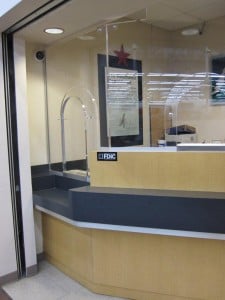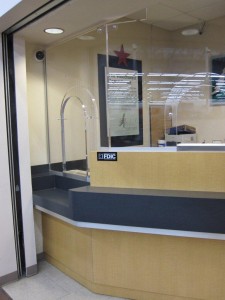Jim Richards, vice president of Total Security Solutions, has been around long enough to have seen his fair share of bad ideas for bulletproof systems. Jim was recently reminded of one project he was asked to bid on:
A national-chain big box store on the fringe of a suburban community had suffered a series of night-time raids. The result: thieves had hijacked several of the store’s big rigs and semi-trailers. A designer working on the store’s renovation called Total Security Solutions, looking to beef up security with bulletproof glass, fiberglass, frames, and a reinforced door for the storage lot’s guard booth.
PROBLEMS BULLETPROOF GLASS CAN’T CURE
When Jim arrived on site he was surprised to learn that these daring night-time raids hadn’t been at gun point; workers had simply discovered the trucks missing in the morning, with nary a peep in the night.
“I don’t know what securing the guard booth was supposed to accomplish; bulletproof glass windows aren’t gonna keep people people from stealing the trucks if no one is paying attention. I mean, the day we went there and measured it, we just drove right up through the gates and started poking around without anyone raising an eyebrow.”
Jim talked the owners out of installing bulletproof glass. “A lot of times it’s just that a designer gets an idea in his head,” Jim sighs. “That seems to be more the trend than practicality. I’ve seen systems installed completely backwards because that’s how the designer wanted to do it.”
EDUCATING CLIENTS ABOUT BULLETPROOF GLASS
A company like Total Security Solutions, which deals in a relatively esoteric product, expends as much effort on educating potential customers as they do on actually designing and installing bulletproof glass systems. Over the years Jim has found that it’s often easiest to educate the clients themselves, as opposed to the designers they’ve hired to renovate a facility. Even though the clients are much less likely to have a designer’s or architect’s familiarity with building materials, construction methods, and engineering, the clients are much more motivated to understand how a ballistic glass system is actually going to keep then and their employees safe.

“The problem with bad designers is that they see bulletproof glass as such a small part in the scheme of things. If someone is building a $25 million building, and the bulletproof system is $40,000 of that job, that’s just a drop in the bucket. It’s really the least of a designer’s concern, and often an afterthought.”
AESTHETICS OVER FUNCTION
All too often Jim has found himself struggling with a designer who sees bullet proof systems as largely aesthetic, instead of functional. “I’ve seen designers make decisions, changing the level of protection, based on how the glass looks rather than threat-level. I’ve had designers insist on using materials or components in situations where the products simply won’t work. The designer will push it through, and then end up having to make modifications and alterations after the fact.”
MAKING SECURITY A TOP PRIORITY
The designer–by the nature of his work and training–is primarily interested in aesthetics: His career hinges on how good a building looks as pictures in his portfolio. The designer doesn’t have to spend every day working behind that bullet proof glass, and will never need to trust it with his life.
“If you can talk directly to the clients, who will be the end users of that bulletproof glass system, and walk them through the process, then usually you can dissuade them from doing anything too odd. But if you’re dealing with some designers–especially less experienced ones–they get something in their minds, and it’s almost impossible to change.”

